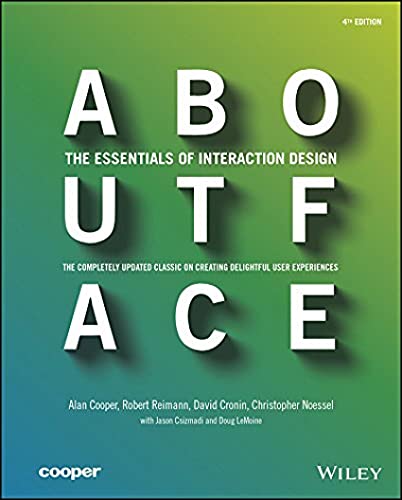
About Face: The Essentials of Interaction Design - by Alan Cooper
ISBN-13: 978-1118766576
This book is a cornerstone text for the discipline of interaction design. It offers a comprehensive guide to designing interfaces that are effective, intuitive, and user-centered. Cooper delves into methodologies and principles essential for crafting engaging digital products. Through detailed analysis and real-world examples, readers gain insights into designing interactions that enhance user experiences. This edition brings new discussions on mobile environments, design for different screen sizes, and more, making it a must-read for designers (and developers!).
MY NOTES
Understanding users is fundamental to creating products they love.
Cooper emphasizes the role of personas in design, a tool for empathizing with and designing for end-users.
Interaction design goes beyond aesthetics; it’s about creating intuitive pathways for users to achieve their goals.
Designing for the digital age requires awareness of various platforms and devices.
"Goal-directed Design" is a key concept, focusing on fulfilling user objectives to drive design decisions.
Collaboration between designers, developers, and stakeholders is crucial for successful interaction design.
Efficient design simplifies complexity to foster user empowerment.
Good design speaks to the user, not at them, creating a conversation rather than a monologue.
Understanding context is key; design not for how we wish things were, but for how things actually are.
Consistency in design isn’t just about aesthetics; it’s about making the user feel at home.
Empathy is the engine of user-centered design. Without it, products are just objects, not experiences.
The best interfaces are those that go unnoticed, seamlessly integrating into the user's task flow.
Anticipating user needs is not guesswork; it’s the result of careful observation and analysis.
Feedback in design is a dialogue; it tells users they’ve been heard and their actions have consequences.
Accessibility isn’t optional; it’s essential. Design for all users, because design inclusivity matters.
Every design decision has a trade-off; understanding these trade-offs is the key to balanced solutions.
Design not for the sake of technology, but for the sake of the user’s experience and needs.
Iterative design is learning distilled; with each iteration, a product moves closer to its ideal form.
Designing with data drives decisions from speculation to strategy.
The gap between what a user says and what they do is where true insights are found.
Personalization in design recognizes the user as an individual, not just another user statistic.
Technology changes, human needs do not. Design principles grounded in human behavior remain relevant.
The most powerful tool in a designer’s arsenal is the ability to ask ‘why’.
Simplicity in design doesn’t mean less functionality; it means clearer pathways to user goals.
Avoiding user frustration is as much a design goal as enhancing user delight.
Great designs are born out of constraints, not despite them.